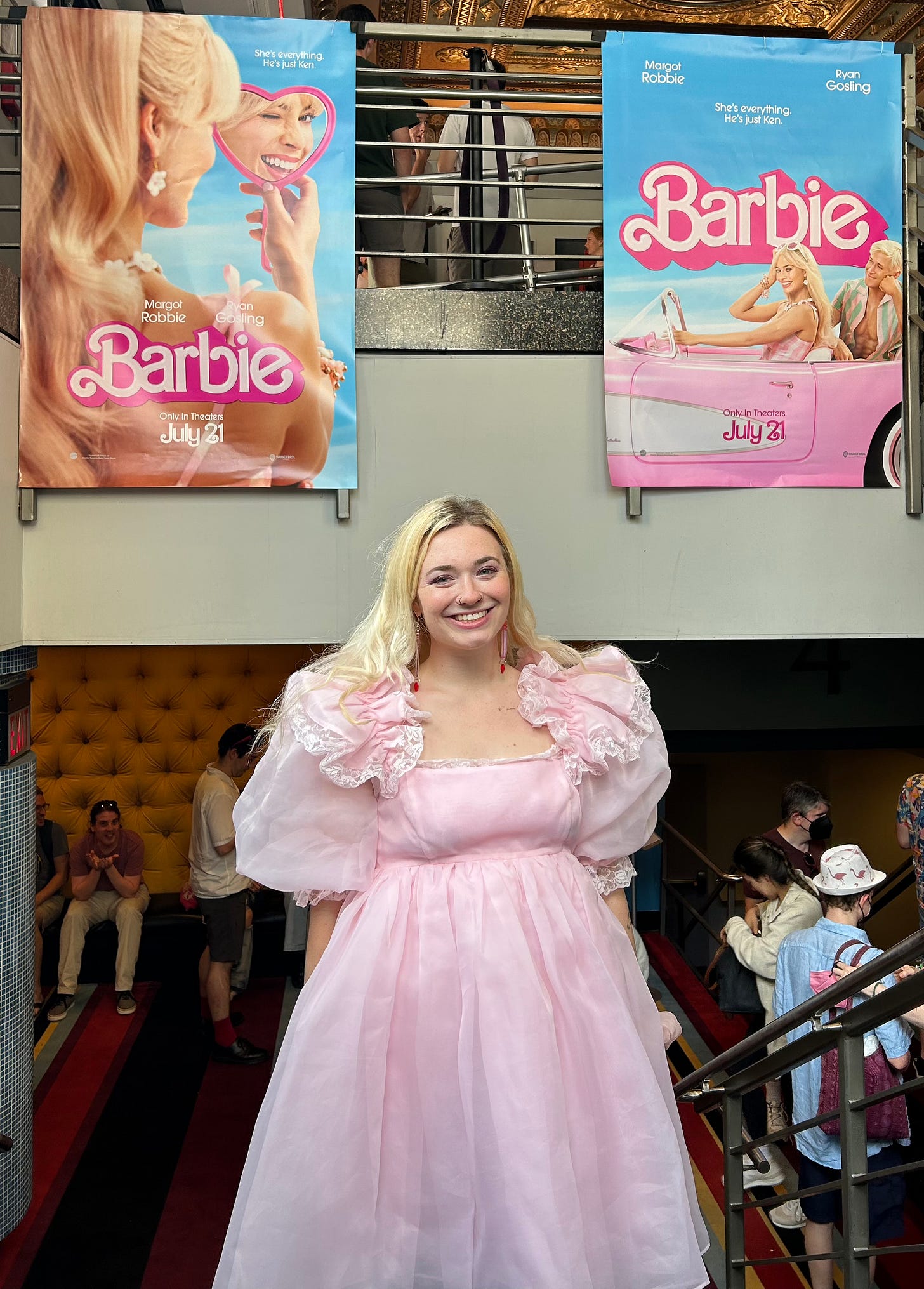
Last weekend saw a pink pilgrimage flocking to movie theaters worldwide for the opening of “Barbie.”
Released July 21, “Barbie” (dir. Greta Gerwig) absolutely delivered at the box office after months of aggressive publicity and the internet-fueled creation of a “Barbie”-”Oppenheimer” double feature (or Barbenheimer). At over $337 million in ticket sales worldwide, “Barbie” had the most successful debut weekend for a movie directed by a woman.
“Oppenheimer” and “Barbie” both have target audiences, but “Barbie”’s is more easily, and broadly, defined: women and girls. “Barbie”’s audience opening weekend was 65% women, the AP found, which is significant in the context of box office history as the highest-grossing movies typically have majority-male audiences— likely due to the lack of blockbuster films catered toward female audiences.
Anecdotally, I know this to be true: hordes of people in their finest pink attire crowded outside theaters in lower Manhattan, and the showing I attended on Sunday was sold out by last Wednesday. My heart went out to the brave movie theater employees everywhere who have been in the trenches scanning tickets and shoveling popcorn for never-ending lines of patrons.
It’s become a de facto rule to wear pink to watch “Barbie,” and theater lobbies are full of be-pinked people taking pictures together with the movie posters or by makeshift displays of Barbie boxes. Wearing pink anywhere in public, in fact, has become a universal signal to initiate a “Hi, Barbie!” call and response.
As someone who does not play about the color pink, I myself have been accosted in such a way, and you better believe I was fully pinked out at my Sunday matinee (thank you, Selkie– and yes, I’m willing to become a brand ambassador.)
While right-wing nut jobs have criticized the movie’s feminist slant, the people this movie catered to had an overwhelmingly positive response. Women have resonated with the movie’s depiction of self-esteem issues, gender roles and mother-daughter relationships as well as that of womanhood’s impossible expectations.
Gerwig’s take on the toy that is both a mainstay, and a caricature, of woman/girlhood is a celebration of femininity that remains self-aware of the challenges women face in a patriarchal society.
Gerwig told W Magazine that she’s fascinated by women: “That ache of contradictions, of never being able to totally bridge that gap between adulthood and childhood, is present in this movie, too. It's this overflowing sense of joy, and then it's also, ‘I can never get back there.’”
That “overwhelming sense of joy” is palpable in the crowds of moviegoers seeing “Barbie,” and I found myself smiling watching strangers’ faces lit up in anticipation of, or earnestly discussing the movie. In the theater itself, the crowd was lively: people laughing, crying and generally enjoying themselves.
In my personal life I’m not too keen on talking to strangers in public, but recently I’ve gone out of my way to talk to, and bonded with, women over “Barbie.” Last week, a barista at one of my favorite coffee shops and I shared our excitement for the movie’s release, and at the movie theater before my showing I complimented a woman wearing a mohawk made of Barbie legs and asked about its origins (she said she was Punk Barbie for Halloween two years ago).
For all that the “Barbie” movie is not, it has shown itself to be a unifying force among women in an era where, often, the only thing bringing the second sex together is the erosion of our rights.
As an elder Gen Z (I guess I’m technically a “zillennial”), the only times I can remember witnessing such solidarity was in 2017 during the women’s march and last summer after the U.S. Supreme Court overturned Roe v. Wade. Those were both political moments driven by urgency, so whatever pride women felt in their gender was overshadowed.
Some have complained the movie didn’t go far enough and portrayed a flat, girlboss-type feminism that isn’t worth the hype, but really, we shouldn’t be looking to a two-hour long Mattel advertisement distributed by Warner Bros. Discovery for salient social commentary.
Sam Adams said in Slate while that’s a paradox, it’s an unavoidable one: “We wouldn’t have seen movie theaters flooded by a sea of pink, or been so powerfully reminded that going to the movies can be an experience of its own” without the capitalist machine that brought it to us.
The “Barbie” premiere in its purest intentions has allowed women to re-experience childlike whimsy, and the movie attempts (to varying degrees of efficacy) to subvert the narrow definition of womanhood Barbie has historically portrayed, allowing women of many backgrounds and experiences to see themselves represented — flaws included. That kind of joy and pride in being a woman that’s not provoked by an imminent threat is a rarity, and a moment I think we need to savor.
Sometimes the best course of action is to let yourself enjoy things, and if girlhood is about one thing, it’s unabashed enjoyment. Reveling in the feminine experience is a luxury women are all too often denied, and the “Barbie” premiere was a pink and sparkly opportunity for women to just have a little fun.
More pieces I liked on “Barbie” and Barbenheimer:
Rolling Stone’s Miles Klee saw the double feature and it changed him.
NBC’s Kalhan Rosenblatt and Daysia Tolentino talked about “Barbie” and bimbo feminism.
NPR’s Aisha Harris wrote a solid review of the movie.
Lyz Lenz, who writes the newsletter Men Yell at Me, examined “Barbie”’s contradictions (and also has more links to related stories, if you’re still feeling starved for “Barbie” analysis).






The punk Barbie lady !!!!!